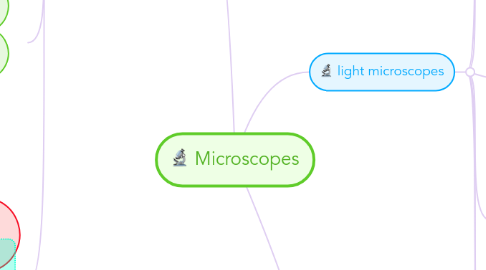
1. electron microscope
1.1. (TEM) Transmission Electron Microscope
1.1.1. a beam of electrons with a wavelength of less than 1mm is used to illuminate the specimen. the beam goes through the specimen.
1.1.1.1. this microscope has the best resolution of 0.5nm
1.2. (SEM) Scanning electron Microscope
1.2.1. A beam of electrons is sent across the specimens surface and reflected electrons are collected.
1.2.1.1. resolution is 3-10nm.
1.2.1.2. produces 3-D images
1.3. Sample preparation
1.3.1. requires a vacuum-to ensure that the beam travels in a straight line
1.3.2. Chemicals-frozen
1.3.3. staining- heavy metals
1.3.3.1. creates contrast in electron beams
1.3.4. dehydration-solvents
1.3.4.1. prevents vaporisation of water in vacuum .Vaporisation damages specimens
1.3.5. Fixation stabilises sample and also prevents decomposition
1.3.6. embedding allows thin slices to be obtained.
1.4. Advantages
1.4.1. Images can be digitally coloured
1.4.2. over x5000000 magnification
1.4.3. high resolving power TEM-0.5NM and SEM-3-10nm
1.5. Disadvantages
1.5.1. expensive
1.5.2. very large and needs to be installed
1.5.3. complex sample preparation
1.5.4. vacuum is required
1.5.5. specimens need to be dead
2. laser scanning Confocal microscopes
2.1. they use visible light to illuminate specimens and a lens to produce a magnified image.
2.2. Moves a single spot of focused light across a specimen.
2.2.1. causes Fluorescence
2.3. the emitted light from specimen is filtered through a pin hole aperture.
2.4. light radiated from very close to the focal plane is detected.
2.5. very high resolution can be obtained
2.6. non-intensive
2.7. beam splitter is a dichroic mirror which reflects one wavelength but allows other wavelengths to pass through.
3. light microscopes
3.1. this has two lenses
3.1.1. objective lens whichis placed near the specimen
3.1.2. eye piece lens. the specimen is viewed from this.
3.1.3. the objective lens produces magnified images, which are them magnified again by the eyepiece lens.
3.1.3.1. this lens configuration produces a higher magnification
3.2. Sample preparation
3.2.1. dry mount-solid specimens are viewed whole or cut into thin slices (sectioning). E.g. hair, pollen and dust. muscle tissues are sectioned.
3.2.2. wet mount-specimens are suspended in water or immersion oil. A cover slip is needed to be placed on top at an angle.
3.2.3. squash slides-a wet mount is first prepared, then a lens tissue is used to gently pressed down the cover slide. this is a better technique is good for soft samples.
3.2.4. smear slides-the edge of a slide is used to smear the sample creating a thin and even coating to another slide. a cover slip is placed over the top.
3.3. Reference to clarity or clearness of image are not relevant when discussing microscopes. it is important to explain that objects have become visibly distant with increased resolution. So more detail can be seen.
3.4. staining-the white light illuminates the whole specimen at once(wide field microscopy), these images have a low contrast and most cells don't absorb the light. the resolution is limited by the wavelength of the light and the diffraction of light as it passes through the sample.
3.4.1. stains increase contrast as different components of a cell take up stains to different degrees.
3.4.2. gram stain technique
3.5. Advantages
3.5.1. inexpensive
3.5.2. portable
3.5.3. simple sample preperation
3.5.4. vacuum is not required
3.5.5. specimens can be dead or alive
3.6. disadvantages
3.6.1. only up to x2000 magnification
3.6.2. resolving power 200nm

